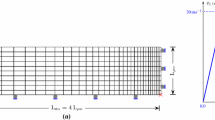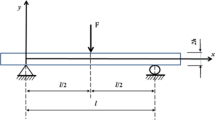Abstract
A large deformation model to predict ductile damage in functionally graded thermoviscoplastic beams is presented in this work. The novelty of the study is the finite element analysis of highly deformable beams considering plastic strains, porosity evolution, strain-rate hardening, thermal softening, heat generation by plastic work and gradual variation of material properties along the thickness direction. The constitutive model adopted is thermodynamically consistent and based on an extension of the Gurson–Tvergaard–Needleman yield criterion, which includes void growth and nucleation, as well as material degradation through cavitation. The finite element adopted is a 2D beam of any order of approximation, transversely enriched in order to reproduce shearing and variable transverse strain across the thickness. To numerically solve the resultant system of equations, the dual-phase procedure, involving elastic trial and internal variables update, is employed together with the backward-Euler integration scheme.
Two numerical examples involving ductile damage under large deformation bending are studied: a cantilever beam and the buckling of a clamped column. Preliminary studies confirm that mesh refinement leads quickly to a converged solution, considering element orders from quadratic up to sixth degree. The concept of functionally graded variation is applied to the material parameters, following two sets extracted from metallic materials. The effect of the gradual variation on the beam response is investigated in detail, in terms of displacements, forces, plastic strains, stresses, temperature and ductile damage. Results show that the gradation of properties has a great influence regarding flexibility and ductility.













Similar content being viewed by others
References
Pascon JP, Waisman H (2021) A thermodynamic framework to predict ductile damage in thermoviscoplastic porous metals. Mech Mater 153:103701. https://doi.org/10.1016/j.mechmat.2020.103701
Gurson AL (1977) Continuum theory of ductile rupture by void nucleation and growth: part I - yield criteria and flow rules for porous ductile media. J Eng Mater Technol 99:2–15. https://doi.org/10.1115/1.3443401
Tvergaard V (1981) Influence of voids on shear band instabilities under plane strain conditions. Int J Fract 17:389–407. https://doi.org/10.1007/BF00036191
Tvergaard V (1982) On localization in ductile materials containing spherical voids. Int J Fract 18:237–252. https://doi.org/10.1007/BF00015686
Tvergaard V, Needleman A (1984) Analysis of the cup-cone fracture in a round tensile bar. Acta Metall 32:157–169. https://doi.org/10.1016/0001-6160(84)90213-X
Thomson RD, Hancock J (1984) Ductile failure by void nucleation, growth and coalescence. Int J Fract 26:99–112. https://doi.org/10.1007/BF01157547
Xu XP, Needleman A (1993) Void nucleation by inclusion debonding in a crystal matrix. Model Simul Mater Sci Eng 1:111. https://doi.org/10.1088/0965-0393/1/2/001
Nahshon K, Hutchinson J (2008) Modification of the Gurson model for shear failure. European J Mech-A/Solids 27:1–7. https://doi.org/10.1016/j.euromechsol.2007.08.002
Gologanu M, Leblond JB, Perrin G, Devaux J (1997). Recent extensions of Gurson’s model for porous ductile metals. In: Suquet P (eds) Continuum Micromechanics. International Centre for Mechanical Sciences. Springer, Vienna.
Danas K, Castañeda PP (2009) A finite-strain model for anisotropic viscoplastic porous media: I - Theory. European Journal of Mechanics-A/Solids 28:387–401. https://doi.org/10.1016/j.euromechsol.2008.11.002
Tvergaard V, Niordson CF (2008) Size effects at a crack-tip interacting with a number of voids. Phil Mag 88:3827–3840. https://doi.org/10.1080/14786430802225540
Lichtenfeld JA, Van Tyne CJ, Mataya MC (2006) Effect of strain rate on stress-strain behavior of alloy 309 and 304L austenitic stainless steel. Metall Mater Trans A 37:147–161. https://doi.org/10.1007/s11661-006-0160-5
Chiou ST, Tsai HL, Lee WS (2007) Effects of strain rate and temperature on the deformation and fracture behaviour of titanium alloy. Mater Trans 48:2525–2533. https://doi.org/10.2320/matertrans.MRA2007607
Sun HT et al (2013) Application of warm forming aluminum alloy parts for automotive body based on impact. Int J Automot Technol 14:605–610. https://doi.org/10.1007/s12239-013-0065-4
Longère P, Dragon A (2013) Description of shear failure in ductile metals via back stress concept linked to damage-microporosity softening. Eng Fract Mech 98:92–108. https://doi.org/10.1016/j.engfracmech.2012.11.009
Kubair DV, Ramesh KT, Swaminathan PK (2015) Effect of shear-void-growth-softening on adiabatic shear-band-spacing in ductile materials. Acta Mech 226:4189–4206. https://doi.org/10.1007/s00707-015-1466-4
Crété JP, Longère P, Cadou JM (2014) Numerical modelling of crack propagation in ductile materials combining the GTN model and X-FEM. Comput Methods Appl Mech Eng 275:204–233. https://doi.org/10.1016/j.cma.2014.03.007
Kubair DV, Lakshmana BK (2008) Cohesive modeling of low-velocity impact damage in layered functionally graded beams. Mech Res Commun 35:104–114. https://doi.org/10.1016/j.mechrescom.2007.09.005
Pascon JP (2018) Large deformation analysis of functionally graded visco-hyperelastic materials. Comput Struct 206:90–108. https://doi.org/10.1016/j.compstruc.2018.06.001
Chi SH, Chung YL (2006) Mechanical behavior of functionally graded material plates under transverse load – Part I: analysis. Int J Solids Struct 43:3657–3674. https://doi.org/10.1016/j.ijsolstr.2005.04.011
Boggarapu V, Gujjala R, Ojha S, Acharya S, Chowdary S, Kumar Gara D (2021) State of the art in functionally graded materials. Compos Struct 262:113596–113598. https://doi.org/10.1016/j.compstruct.2021.113596
Pai PF, Nayfeh AH (1994) A fully nonlinear theory of curved and twisted composite rotor blades accounting for warpings and three-dimensional stress effects. Int J Solids Struct 31:1309–1340. https://doi.org/10.1016/0020-7683(94)90123-6
Pai PF, Palazotto A (1996) Large-deformation analysis of flexible beams. Int J Solids Struct 33:1335–1353. https://doi.org/10.1016/0020-7683(95)00090-9
Holzapfel GA (2002) Nonlinear solid mechanics: a continuum approach for engineering science. England, Chichester
Benatta MA, Mechab I, Tounsi A, Bedia EA (2008) Static analysis of functionally graded short beams including warping and shear deformation effects. Comput Mater Sci 44:765–773. https://doi.org/10.1016/j.commatsci.2008.05.020
Arbind A, Reddy JN (2013) Nonlinear analysis of functionally graded microstructure-dependent beams. Compos Struct 98:272–281. https://doi.org/10.1016/j.compstruct.2012.10.003
He G, Yang X (2014) Finite element analysis for buckling of two-layer composite beams using Reddy’s higher order beam theory. Finite Elem Anal Des 83:49–57. https://doi.org/10.1016/j.finel.2014.01.004
Pascon JP (2016) Finite element analysis of flexible functionally graded beams with variable Poisson’s ratio. Eng Comput 33:2421–2447. https://doi.org/10.1108/EC-08-2015-0225
Nguyen TN, Ngo TD, Nguyen-Xuan H (2017) A novel three-variable shear deformation plate formulation: theory and Isogeometric implementation. Comput Methods Appl Mech Eng 326:376–401. https://doi.org/10.1016/j.cma.2017.07.024
Nguyen TN, Thai CH, Luu AT, Nguyen-Xuan H, Lee J (2019) NURBS-based postbuckling analysis of functionally graded carbon nanotube-reinforced composite shells. Comput Methods Appl Mech Eng 347:983–1003. https://doi.org/10.1016/j.cma.2019.01.011
Tham CL, Zhang Z, Masud A (2005) An elasto-plastic damage model cast in a co-rotational kinematic framework for large deformation analysis of laminated composite shells. Comput Methods Appl Mech Eng 194:2641–2660. https://doi.org/10.1016/j.cma.2004.07.050
Yuan Y, Tan PJ, Shojaei KA, Wrobel P (2016) Large deformation, damage evolution and failure of ductile structures to pulse-pressure loading. Int J Solids Struct 96:320–339. https://doi.org/10.1016/j.ijsolstr.2016.05.019
Pascon JP, Daniel VM (2022) A finite element formulation for highly deformable elastoplastic beams accounting for ductile damage and plane stress state. Mech Solids 57:1194–1213. https://doi.org/10.3103/S0025654422050119
Cheng F (2013) Multiscale Computational Modeling of Multiphase Composites with Damage (Doctoral dissertation). Texas A&M University. https://hdl.handle.net/1969.1/151769
Gurtin ME, Fried E, Anand L (2010) The mechanics and thermodynamics of continua. Cambridge University Press
Dettmer W, Reese S (2004) On the theoretical and numerical modelling of Armstrong-Frederick kinematic hardening in the finite strain regime. Comput Methods Appl Mech Eng 193:87–116. https://doi.org/10.1016/j.cma.2003.09.005
Lubarda VA (2004) Constitutive theories based on the multiplicative decomposition of deformation gradient: thermoelasticity, elastoplasticity, and biomechanics. Appl Mech Rev 57:95–108. https://doi.org/10.1115/1.1591000
Pascon JP (2022) A large strain one-dimensional ductile damage model for space truss analysis considering Gurson’s porous plasticity, thermal effects and mixed hardening. J Braz Soc Mech Sci Eng 44:186
Aldakheel F, Wriggers P, Miehe C (2018) A modified Gurson-type plasticity model at finite strains: formulation, numerical analysis and phase-field coupling. Comput Mech 62:815–833. https://doi.org/10.1007/s00466-017-1530-0
Chu C, Needleman A (1980) Void nucleation effects in biaxially stretched sheets. J Eng Mater Technol 102:249–256. https://doi.org/10.1115/1.3224807
Arndt S, Klingbeil D, Svendsen B (1997) On the simulation of warm-prestressing and ductile crack extension by constitutive modeling. In: Transactions on the 14th International Conference on Structural Mechanics in Reactor Technology (SMiRT 14), Lyon, France.
Knysh P, Korkolis YP (2015) Determination of the fraction of plastic work converted into heat in metals. Mech Mater 86:71–80. https://doi.org/10.1016/j.mechmat.2015.03.006
Jones A, Reedlunn B, Jones E, Kramer SL (2018) Conversion of Plastic Work to Heat: A full-field study of thermomechanical coupling. Sandia National Lab. (SNL-NM), Albuquerque, NM, United States
McAuliffe C, Waisman H (2015) A unified model for metal failure capturing shear banding and fracture. Int J Plast 65:131–151. https://doi.org/10.1016/j.ijplas.2014.08.016
Svolos L, Bronkhorst CA, Waisman H (2020) Thermal-conductivity degradation across cracks in coupled thermo-mechanical systems modeled by the phase-field fracture method. J Mech Phys Solids 137:103861. https://doi.org/10.1016/j.jmps.2019.103861
Coda HB, Paccola RR (2007) An alternative positional FEM formulation for geometrically non-linear analysis of shells: curved triangular isoparametric elements. Comput Mech 40:185–200. https://doi.org/10.1007/s00466-006-0094-1
Duff IS (2004) MA57–-a code for the solution of sparse symmetric definite and indefinite systems. ACM Transact Math Softw 30:118–144. https://doi.org/10.1145/992200.992202
Paccola R, Coda H (2005) AcadView 1.0. structural engineering department, São Carlos School of Engineering, University of São Paulo.
Becker R, Needleman A, Richmond O, Tvergaard V (1988) Void growth and failure in notched bars. J Mech Phys Solids 36:317–351. https://doi.org/10.1016/0022-5096(88)90014-2
McAuliffe C, Waisman H (2016) A coupled phase field shear band model for ductile–brittle transition in notched plate impacts. Comput Methods Appl Mech Eng 305:173–195. https://doi.org/10.1016/j.cma.2016.02.018
Skripnyak V, Kozulin AA, Skripnyak EG, Skripnyak V (2018) Fracture of alpha titanium alloys at high strain rates and stress triaxiality. Proc. of the Inter. Conf. on Computational Methods 9th ICCM, Rome, Italy, 5:546
Bong HJ, Kim D, Kwon YN, Lee J (2021) Predicting hot deformation behaviors under multiaxial loading using the Gurson-Tvergaard-Needleman damage model for Ti–6Al–4V alloy sheets. European J Mech-A/Solids 87:104227–104298. https://doi.org/10.1016/j.euromechsol.2021.104227
Roth CC, Mohr D (2014) Effect of strain rate on ductile fracture initiation in advanced high strength steel sheets: experiments and modeling. Int J Plast 56:19–44. https://doi.org/10.1016/j.ijplas.2014.01.003
Acknowledgements
The author appreciates all the support provided by the Materials Engineering Department of the Lorena School of Engineering of the University of São Paulo, and also the financial aid granted by Fundação de Amparo à Pesquisa do Estado de São Paulo (FAPESP), Brazil.
Funding
Funding was provided by Fundação de Amparo à Pesquisa do Estado de São Paulo, 2021/03954-1, João Pascon
Author information
Authors and Affiliations
Corresponding author
Ethics declarations
Conflict of interest
The author declared no potential conflicts of interest concerning this article’s research, authorship, and publication.
Additional information
Technical Editor: Aurelio Araujo.
Publisher's Note
Springer Nature remains neutral with regard to jurisdictional claims in published maps and institutional affiliations.
Rights and permissions
Springer Nature or its licensor (e.g. a society or other partner) holds exclusive rights to this article under a publishing agreement with the author(s) or other rightsholder(s); author self-archiving of the accepted manuscript version of this article is solely governed by the terms of such publishing agreement and applicable law.
About this article
Cite this article
Pascon, J.P. Large deformation analysis of functionally graded thermoviscoplastic beams under ductile damage via finite elements. J Braz. Soc. Mech. Sci. Eng. 45, 461 (2023). https://doi.org/10.1007/s40430-023-04395-4
Received:
Accepted:
Published:
DOI: https://doi.org/10.1007/s40430-023-04395-4




